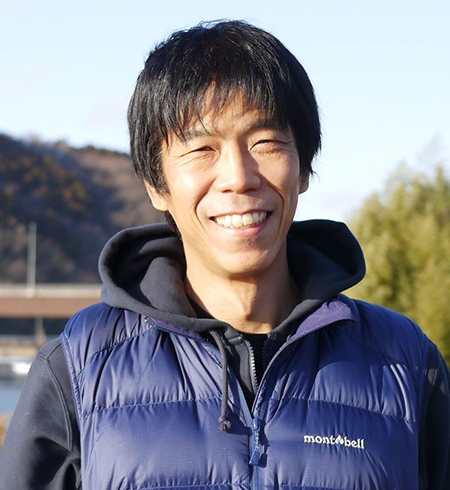| Career |
Education: BSc in Ecology, School of Biological Science, Univ. of East Anglia, UK (2002), Ph.D. in Environmental Management, Environment Department, Univ. of York, UK (2007)
Research Experience: Postdoctoral Research Associate, Univ. of Aberdeen, UK (2007-2009), BP Fellow, Univ. of Aberdeen (2009-2017), Assistant Prof. Tohoku Univ. (2017―2018), Associate Prof., Tohoku Univ. (2018-present) |
- Tohoku Ecosystem-Associated Marine Sciences (TEAMS) and Socio-Ecological System Dynamics in Coastal Environments
Currently, I investigate the impacts of the 2011 Great East Japan Earthquake and subsequent tsunami on the dynamics of marine coastal ecosystem in Onagawa Bay, Japan, to better understand the potential influence of coastal anthropogenic activities on the ecological responses of marine benthic and pelagic populations around the disaster-affected coastal region. The 2011 Tohoku disaster severely damaged extensive areas of the Pacific coast of the Tohoku region in northern Japan. In order to measure the extent of the damage caused by the disaster and to monitor the subsequent change in the state of the marine environment, the “Tohoku Ecosystem-Associated Marine Sciences” (TEAMS) project was launched. As part of this study, I have been involved in conducting a coordinated monitoring program to obtain a holistic view on the spatio-temporal dynamics of the marine ecosystem of Onagawa Bay. Using such multi-layered information, I aim to construct a dynamic marine habitat map for Onagawa Bay to take account of the spatio-temporal dynamics of the whole coastal ecosystem in response to the 2011 Tohoku disaster. Through this project, I would like to make a significant contribution in developing a unifying multiple-stressors approach for the study of marine socio-ecological system dynamics in order to efficiently understand, predict and manage marine environments and resources. - Ecological Performance of Offshore Oil Platforms in the North Sea
In this programme, I investigated the relationship between the quality/quantity of marine bio-resources (e.g. biodiversity, fish stocks) and the physical presence of sub-sea large artificial structures in the marine environment in order to understand the potential role of offshore energy infrastructure in the ecology of marine populations in the North Sea. There are currently over 7500 offshore installations worldwide extracting oil and gas primarily from the continental shelf. Further, there is a major expansion of marine renewable energy developments (e.g. offshore wind/wave/tidal energy infrastructure) in the shallow open coastal waters throughout the globe. Introduction of these offshore energy facilities represents one of the most extensive anthropogenic habitat-modifications made to any marine ecosystems. Marine policy issues surrounding these activities therefore are of global significance. Recent studies have suggested the physical presence of such structures may in fact have beneficial effects for fisheries. This is because they provide extensive surface area of hard substrata for fouling organisms and thereby serve as artificial reefs that attract marine life in the proximity of these foundations. This research thus aimed to elucidate patterns of fish population dynamics in relation to changes in various environmental and anthropogenic parameters (e.g. climate change, fishery) with particular reference to the installation history of offshore artificial structures in order to predict the ecological consequences of alternative decommissioning options of obsolete offshore oil and gas structures in the North Sea. - HADEEP – Life at Extreme Depth: Benthic Fishes and Scavenging Fauna of the Abyssal to Hadal Boundary
In this research, I was responsible for undertaking direct studies on the life of the deepest-living fauna and their biogeographic distributions across multiple trench ecosystems. Specifically, I investigated the distribution and behaviour of the deep-sea fishes and benthic fauna of the abyssal (3000-6000 m) to hadal (> 6000 m) boundary using free-fall baited camera landers (12000m-rated) and fish traps. Through this project, I became experienced in day to day work on a ship, execution of the cruises, handling specialist aspects of deep-sea lander operation and data analysis. This project has raised fascinating questions about the biogeographic distribution of the trench-dwelling fauna and their association with contemporary environmental change/anthropogenic influences. I also co-organised an international symposium on the deepest environment on earth entitled “Trench Connection” held in Tokyo in 2010, which aimed to bring together the international scientific community for the first time to meet and discuss current understanding of deep-sea trench environments and provided great opportunities to identify future directions of hadal (> 6000m) science, which in turn shed new light on the broader role of hadal trench ecosystems. - “Impacts of Sea-Level Rise on an Estuarine Ecosystem: A case Study of the Humber Estuary, UK” (Ph.D. Thesis)
I completed Ph.D. in Environmental Management at University of York, UK. My thesis was entitled “Impacts of Sea-Level Rise on an Estuarine Ecosystem: A case Study of the Humber Estuary, UK” in which I examined how the abundance and biomass of benthic macrofauna are likely to change in response to physical environmental changes resulting from sea-level rise, and how this will in turn affect the consumers they support, especially fish, shrimps and shorebirds in an estuarine ecosystem.
|




